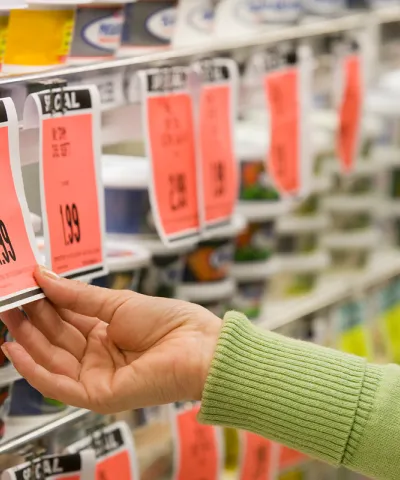Personalized marketing helps you build a one-on-one connection with your customer. Using data to deliver a human-centric, tailored experience not only drives revenue and increases loyalty, it also sets you on the right path to growth because you are always actively listening to your customers!
Still relying on third-party tracking as part of your personalization strategy? With Apple’s move to more stringent privacy laws, and Google phasing out advertising cookies by 2023, moving away from third-party tracking is inevitable. Customers are demanding greater privacy, which includes more choice, control and transparency regarding how their personal information is used. Yet in 2021 over 50 percent of US companies reported that they still relied heavily on third-party cookies, accounting for the majority of data they used in digital advertising.
So what does this mean for the future of personalized marketing? Companies will have to pull out additional stops to draw customers to their own apps and landing pages.
What is personalized marketing?
When personalized marketing works, customers feel valued or recognized without them feeling like they're being profiled. Or, they even embrace sharing their information because they immediately see the benefits to them: a convenient, seamless, contextually relevant, and tailored experience that circumvents the hassles of everyday life. In a recent report on Personalization after COVID-19, 75 percent of consumers stated that they are more likely to buy from brands that offer personalized digital experiences.
So, if you can save your customer some time, simplify the decision-making process, and find the perfect “match” between your offering and their unmet needs, then that connection might just be strong enough to keep them coming back, time and time again.
Personalized marketing has always been about meeting the customer where they want to be met. But nowadays, having a customer focus with a personal touch goes beyond just “targeting”. Another way to think about personalized marketing is the relationship and trust you share with your customers. It means showing you care for them like you would a close friend. You don’t stalk customers, and you don’t spam them in an already noisy and cluttered environment. Rather, you understand their needs and you help to solve their problems with better suggestions and alternatives. You also authenticate you email domain with DMARC to enhence it's credibility and increase trust.
In short: When personalized marketing is done effectively, it makes your customer feel valued and remembered, benefiting both the customer and the company/brand.
Benefits of personalized marketing
Examples of benefits for customers | Examples of benefits for companies |
Relevant customer experience | Increased customer acquisition and retention |
Alleviated decision-making | Higher conversion rates |
Seamless transition between channels | Stronger brand loyalty and customer engagement across channels |
Tailored product recommendations | Higher brand affinity |
Anticipation and fulfilment of needs | Higher revenues with cross-selling and up-selling opportunities |
When should you use personalized marketing?
Really, when shouldn’t you use it? Whether you are a B2B or B2C business, you should always know what your customers want, even before they do. And according to Salesforce’s 2020 Trends in Personalization Report, 97 percent of marketers observe better business outcomes thanks to their personalization efforts.
Let’s imagine a typical car sales scenario. Before the customer arrives at the showroom, the sales rep can look up some basic information about the customer, such as their gender, age group, household income, etc. According to these basic segmentation criteria, there is already an indication of what type of vehicle the customer might be interested in. However, after having spoken to the customer in person and getting to know a little more about them, the sales rep learns that the buyer has two school-aged children who they will soon pick up from soccer practice. It’s currently raining, the field will be muddy, and on the way home they will stop at a drive-through so that the kids have something to eat in the back of the car. The sales rep now understands that the customer will also be looking for an interior that is easy to clean.
This ability to dig deeper into the customers’ needs isn’t restricted to the car showroom. It is highly relevant in the digital environment too, and can be the difference between a successful sale and a missed opportunity. What’s needed are the right capabilities and tools to replace that personal experience and rapidly capture a snapshot of relevant information. A great example is how Airbnb pivoted its business strategy and adapted to the “new normal” amidst the COVID-19 pandemic by adjusting its algorithm to suggest more experiential local stays for longer durations.
What does successful personalized marketing look like?
At Simon-Kucher elevate, we have identified three key success factors among companies that get the most out of their personalization efforts:
1. Dynamic empathy mapping and user type segmentation
Whatever your business, you need to be able to follow the customer journey and explore the problems that the customer is facing. How does your customer’s problem align with your product's value proposition? Are you able to meet their needs? Do you understand their problems and intent? If so, what type of personalized content could you send that customer to assure them that you can help?
If they are not interacting with your content, maybe it is just not resonating enough and the messaging needs to be reworked, or perhaps the small window of opportunity has already closed – you weren’t quick enough. Resonance, and timing, are paramount in personalization, and segmentation should be as dynamic as possible.
When leveraging empathy mapping and user type segmentation in addition to your brand personas, you must be proactively reactive. So if you’re using customer data you captured six months ago, you are already behind. Personalization should not be based on static data – the necessary insights must be captured in real time and interpreted with relevance to the current moment and the near future. You need to find patterns in your customer data and identify what’s trending in the world around you. These dimensions are critical and only testing can provide the answers. Without A/B testing, you will never know what works and what doesn’t.
2. Personalization strategy meets digital strategy
Think about a recent, positive online shopping experience. Was the interface easy to use, with a minimized number of clicks and pages to navigate? If you abandoned your search and returned later, did you find yourself on your most recently viewed page? Perhaps you received a follow-up text offering incentives to recover a sale, such as a discount, free shipping, or entry into a contest.. Or, you maybe even received a personalized email reminding you of a product you had forgotten in your shopping basket, or a product complementary to something you had recently purchased. These are just a few examples of personalized marketing that customers encounter during a personalized buying experience.
However, personalization isn’t something that just happens in the frontend. There is a lot going on in the backend that customers don’t get to see. Knowing whether a customer is interacting with a webpage or mobile app as intended and whether the message is simple, clear and adding value requires a powerful and integrated technology stack (perhaps, with a headless architecture). Impressive AI and Machine Learning models behind the scenes are diving deeply into community building, purchase history, customer interests, etc., so that all personalized experiences are seamlessly and automatically delivered to customers.
How you choose your technology stack, how you set up your data architecture, and how you choose your MarTech vendors to help deliver on your brand value proposition at an optimized cost, will all play an important role in your success. It is crucial to have a decoupled tech stack in the backend that can deliver on your personalization promise.
3. Identifying the right metrics
Always ask the “so what” question and avoid vanity metrics such as “likes” or “reach”. It might be impressive to reach five billion people, but what did those five billion people do except maybe increase your ad spend? Regardless of whether a customer shared, liked, or commented on your social media post, did they do what you intended them to do? So what if they liked it? What happened after that? Did they go to your web page, and did they buy it? Most importantly, did you learn anything about your customer from that engagement (e.g., via an Instagram comment) which now enables you to solve their problem?
Look at metrics that translate into top-line revenue – e.g. those which help you to increase your customer retention, extend your customer lifecycle value, and directly convert sales. These will show you whether you are being strategic and intuitive enough to get the best out of your customers. If you are not hitting those top-line metrics, it’s time to go back to the data and experiment with another phase of A/B testing.
At Simon-Kucher Elevate, we have extensive experience in mapping customer empathy drivers such as expressions, problems, and intent, bridging the gap between data generation and insights so that companies can track their customers’ motivations and anticipate their needs as quickly as possible. We combine this with our in-depth knowledge of behavioral science, such as how to use biases, anchors, and nudges – all without customers feeling like they are being monetized.
Want to find out more? Discover how we helped our client in the banking industry to increase digital acquisition through data-driven buying personas and incorporation of behavioral economics. The result? More than 29 percent potential increase in revenues and over 15 percent increase in acquisition thanks to our marketing improvements!








